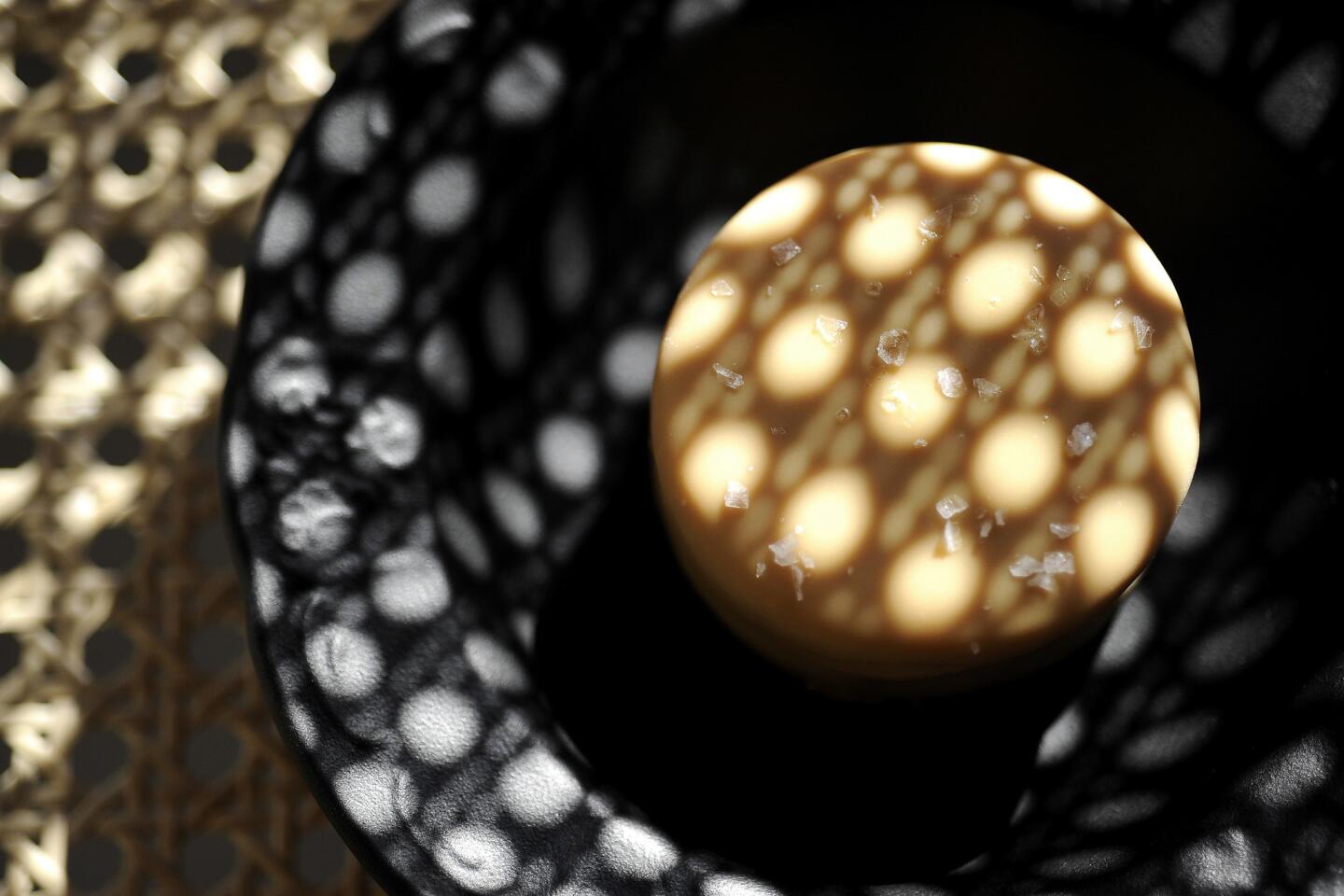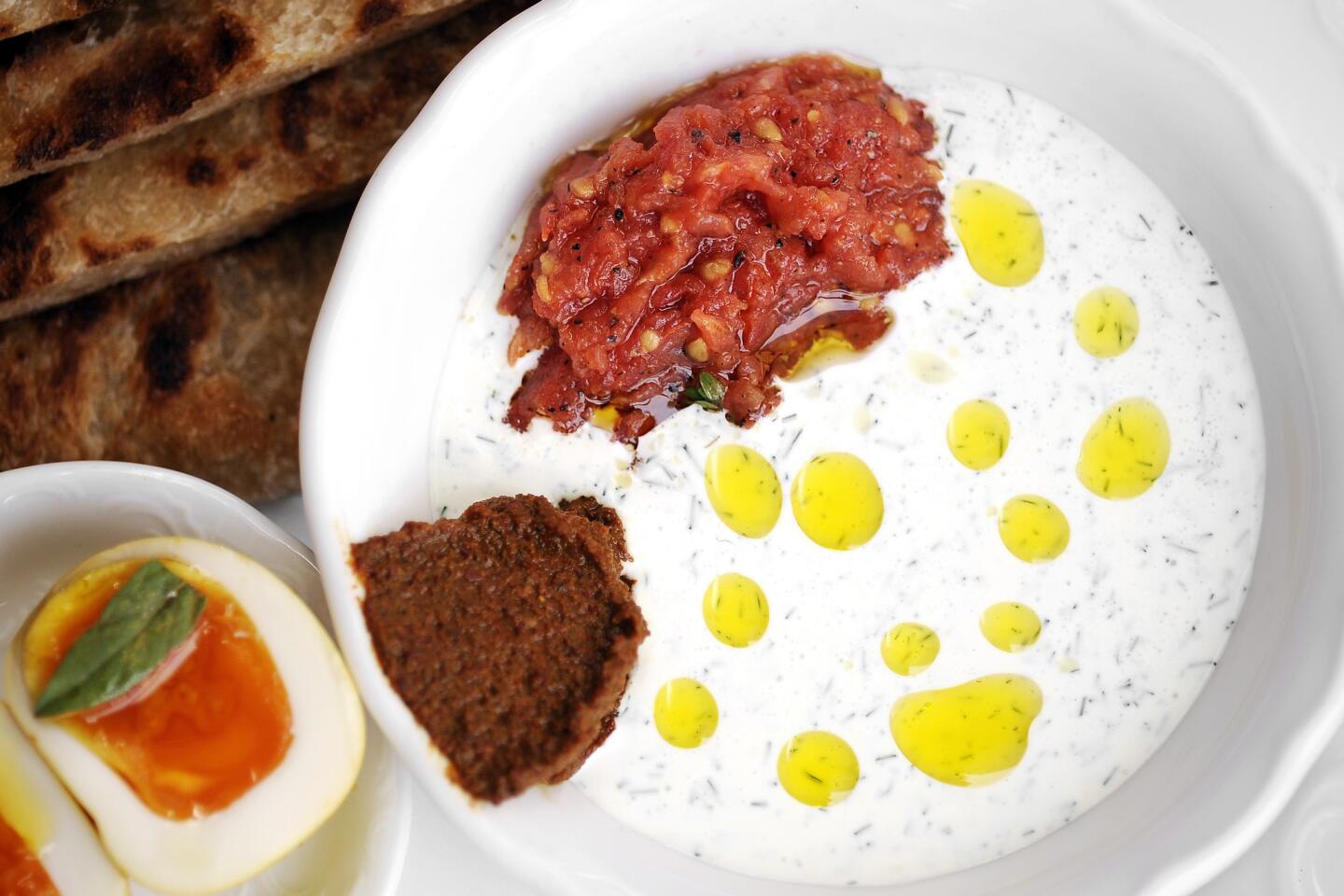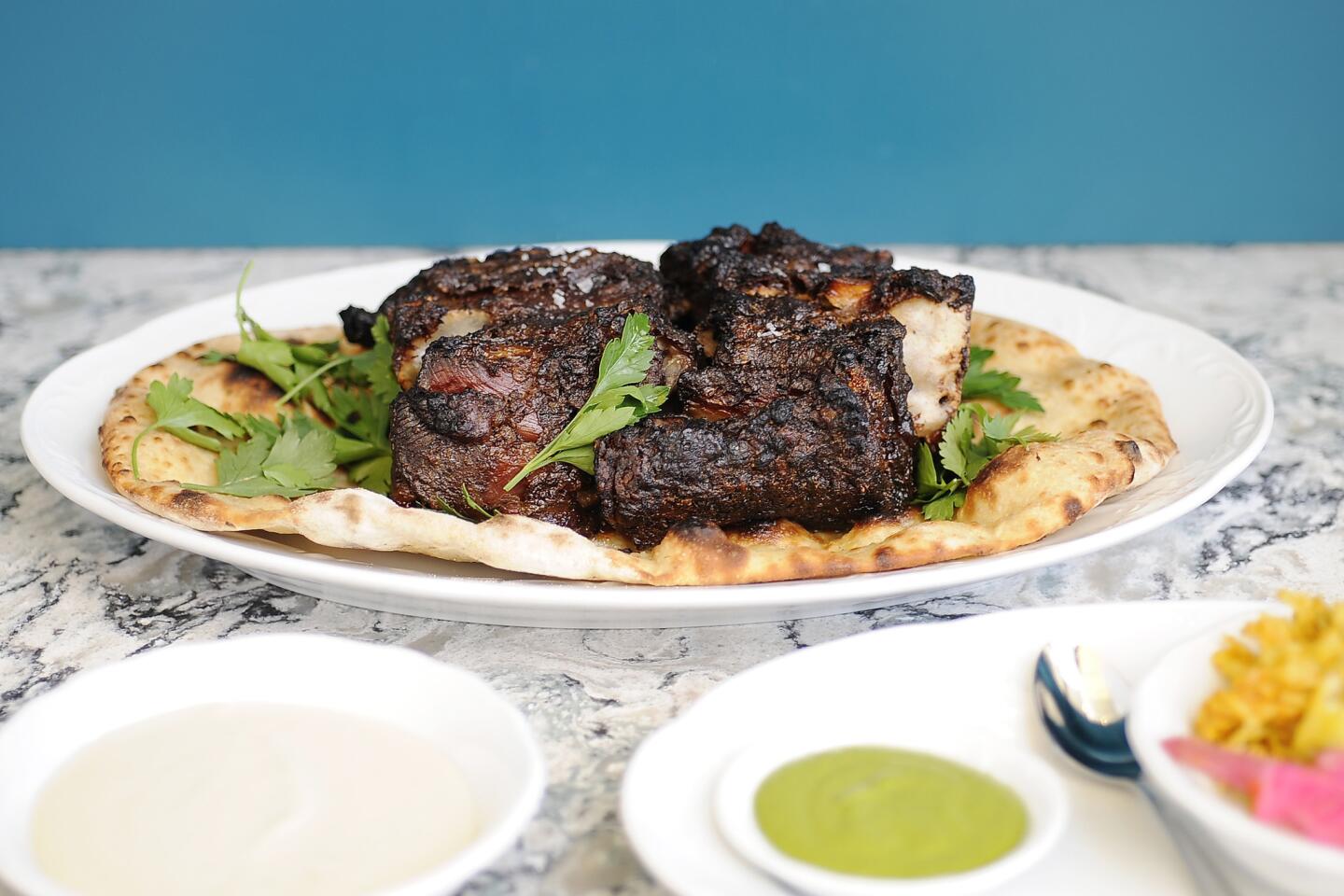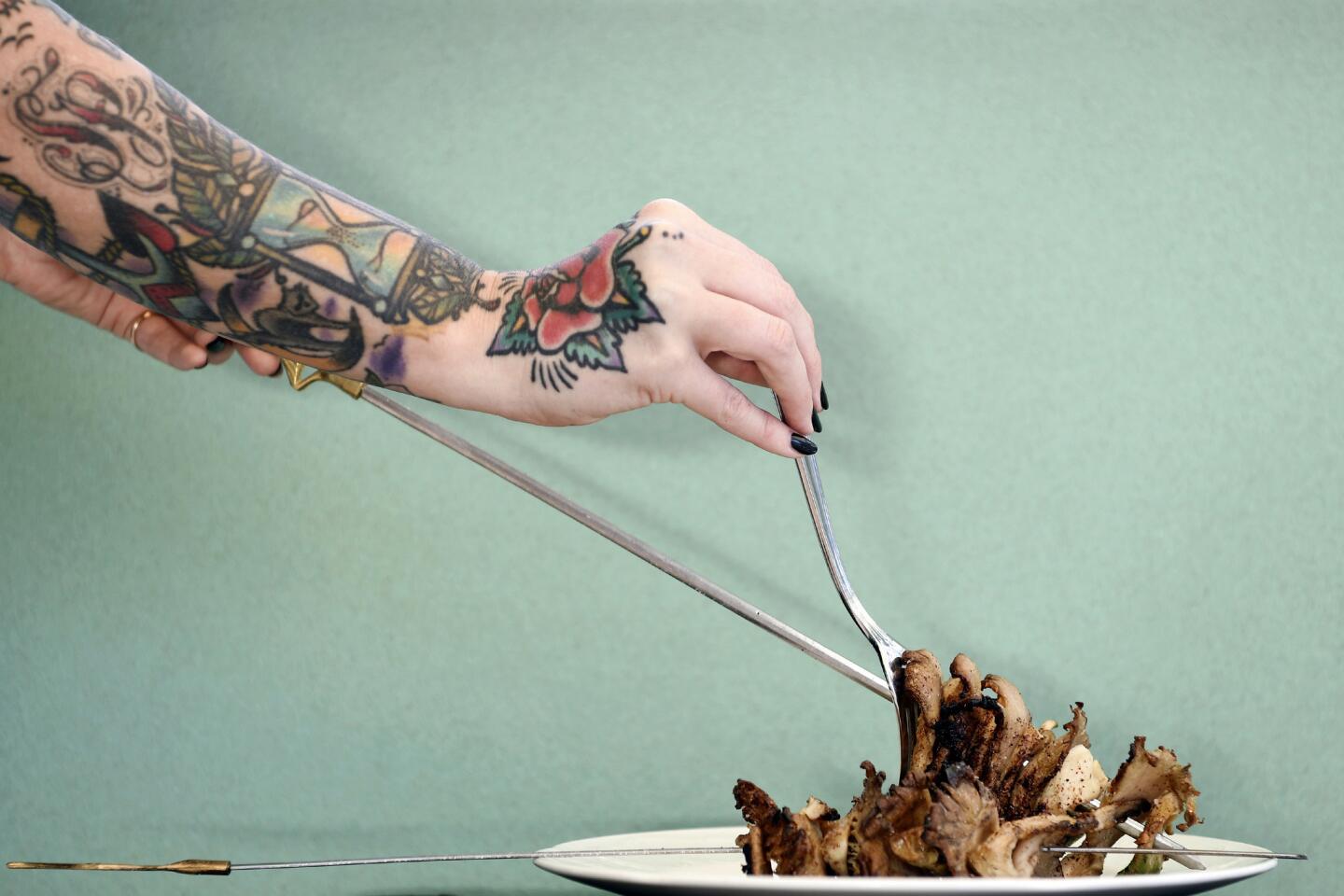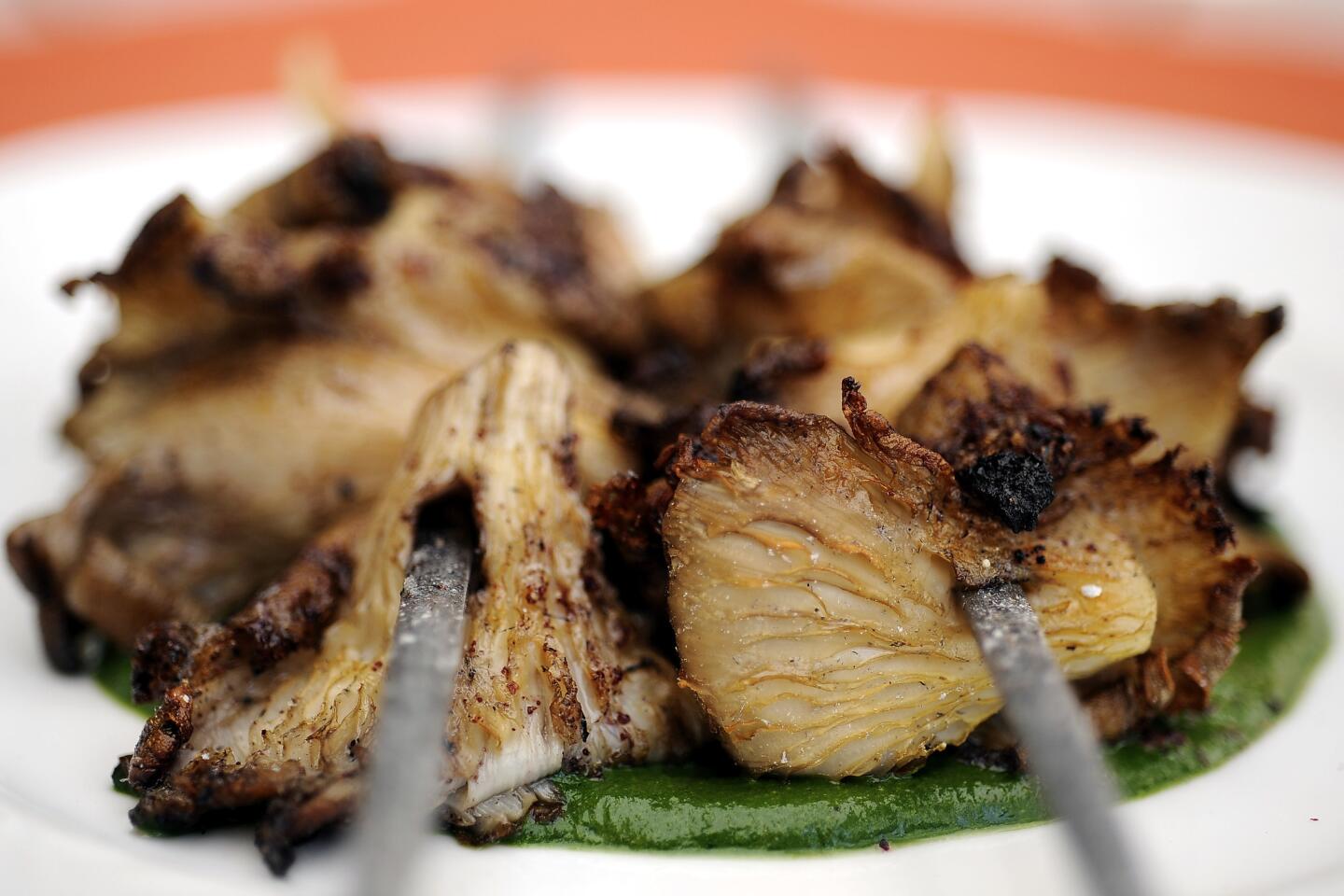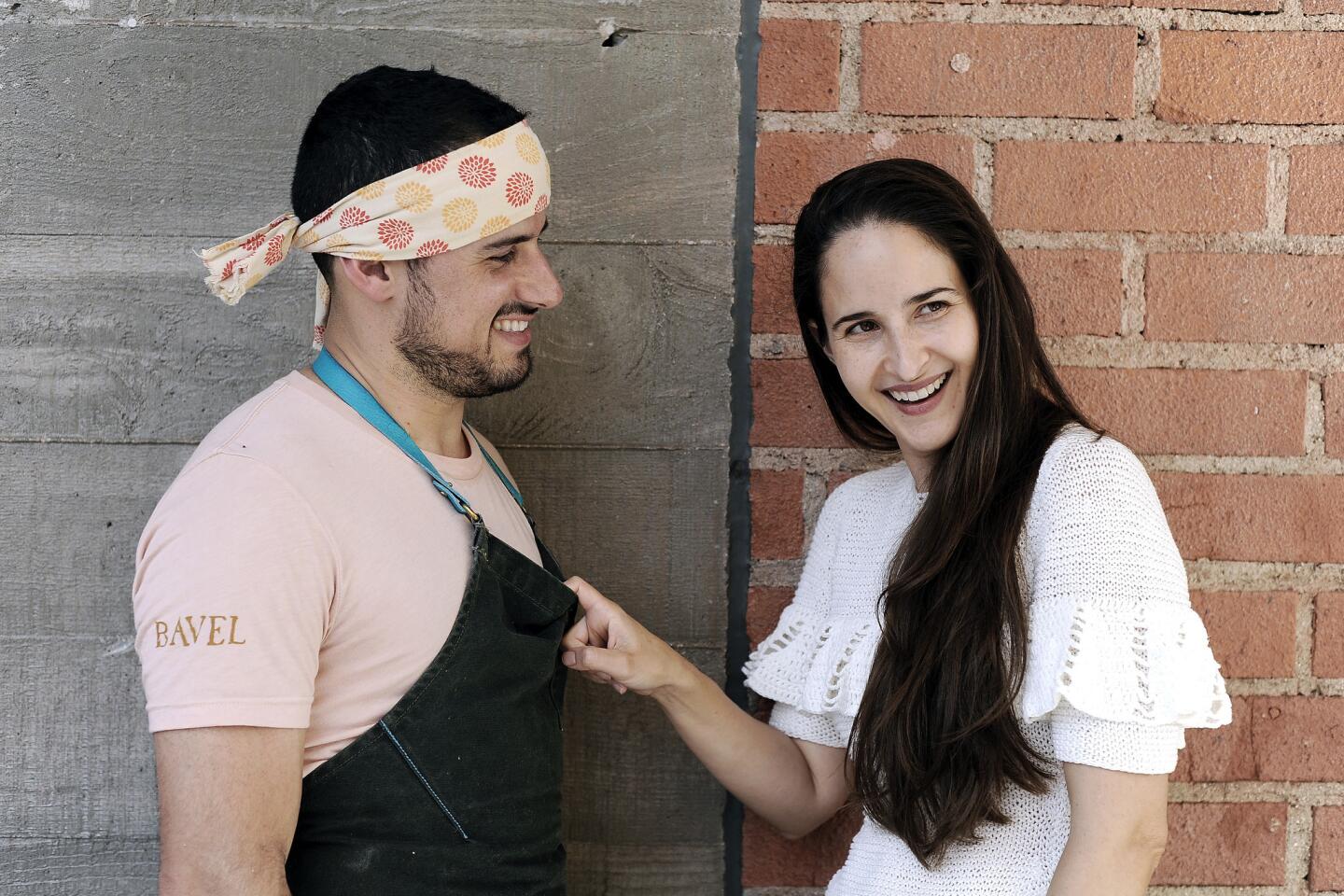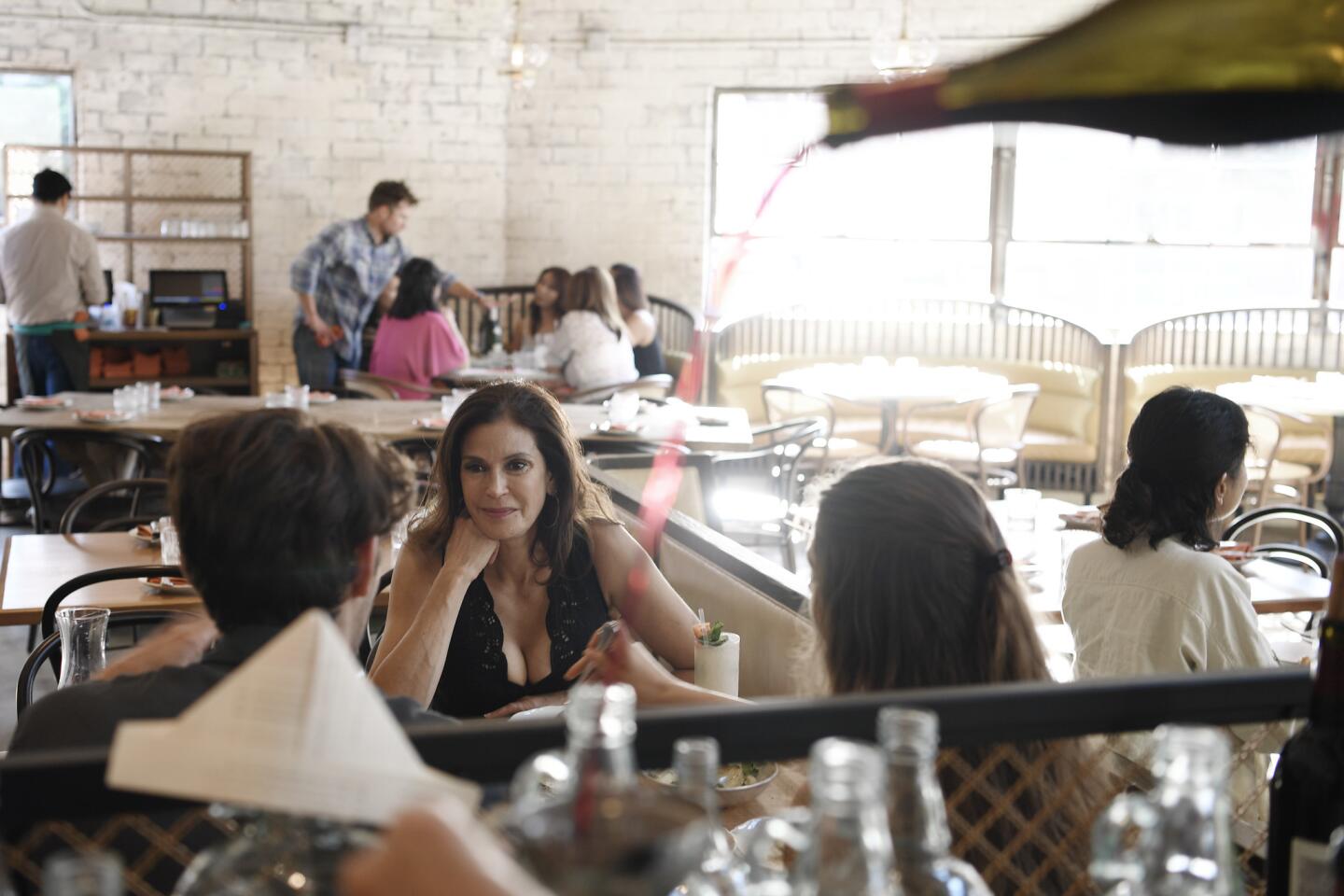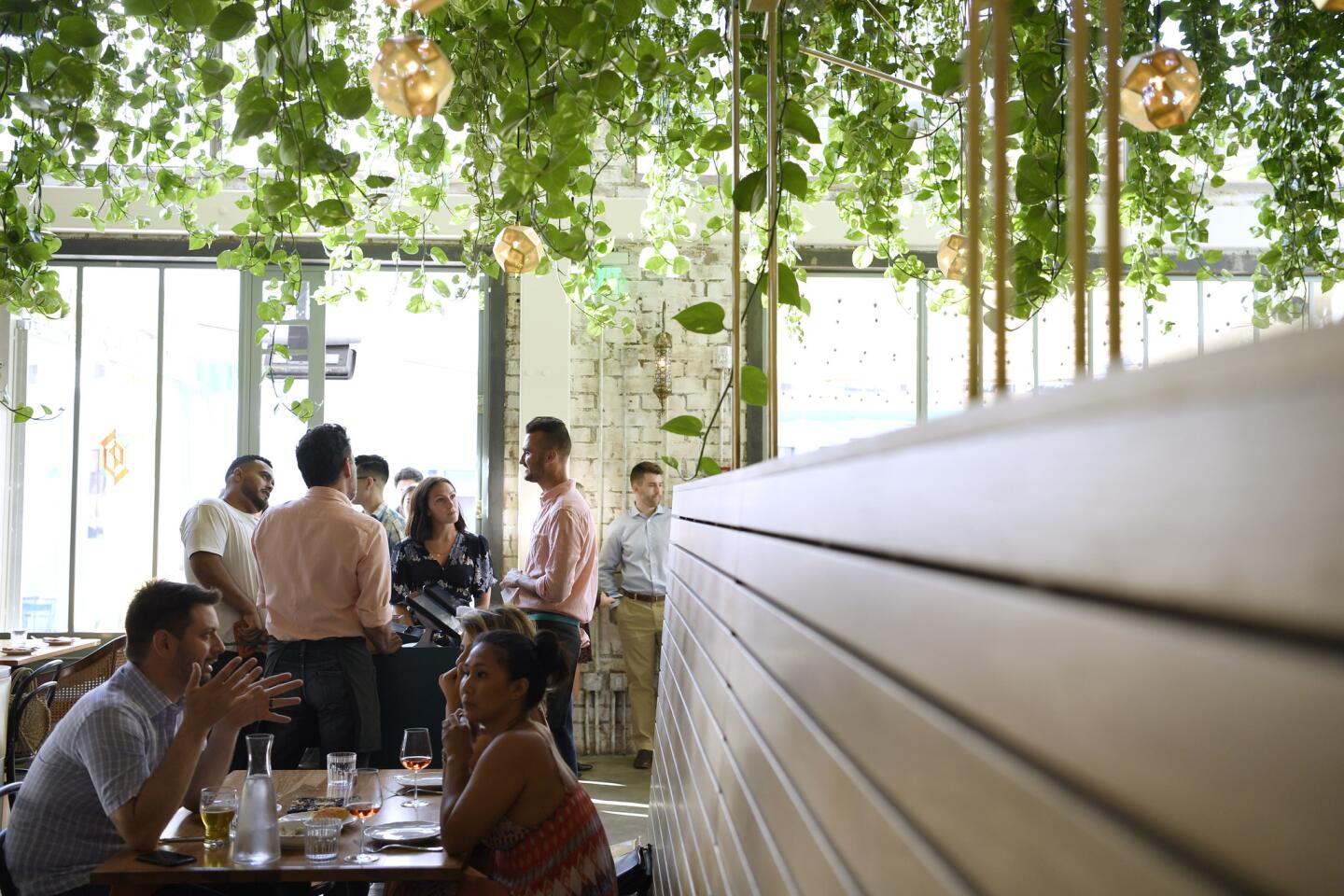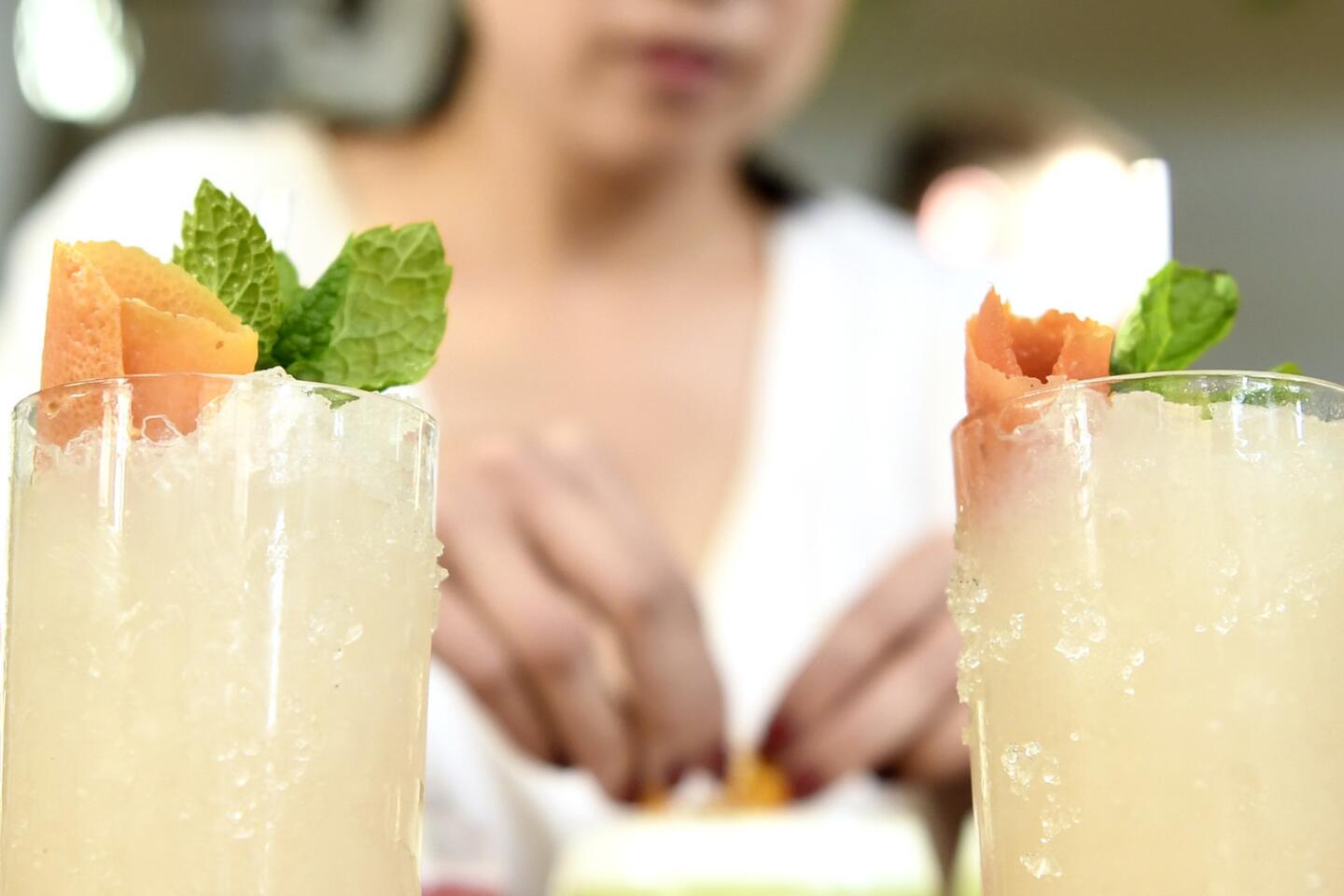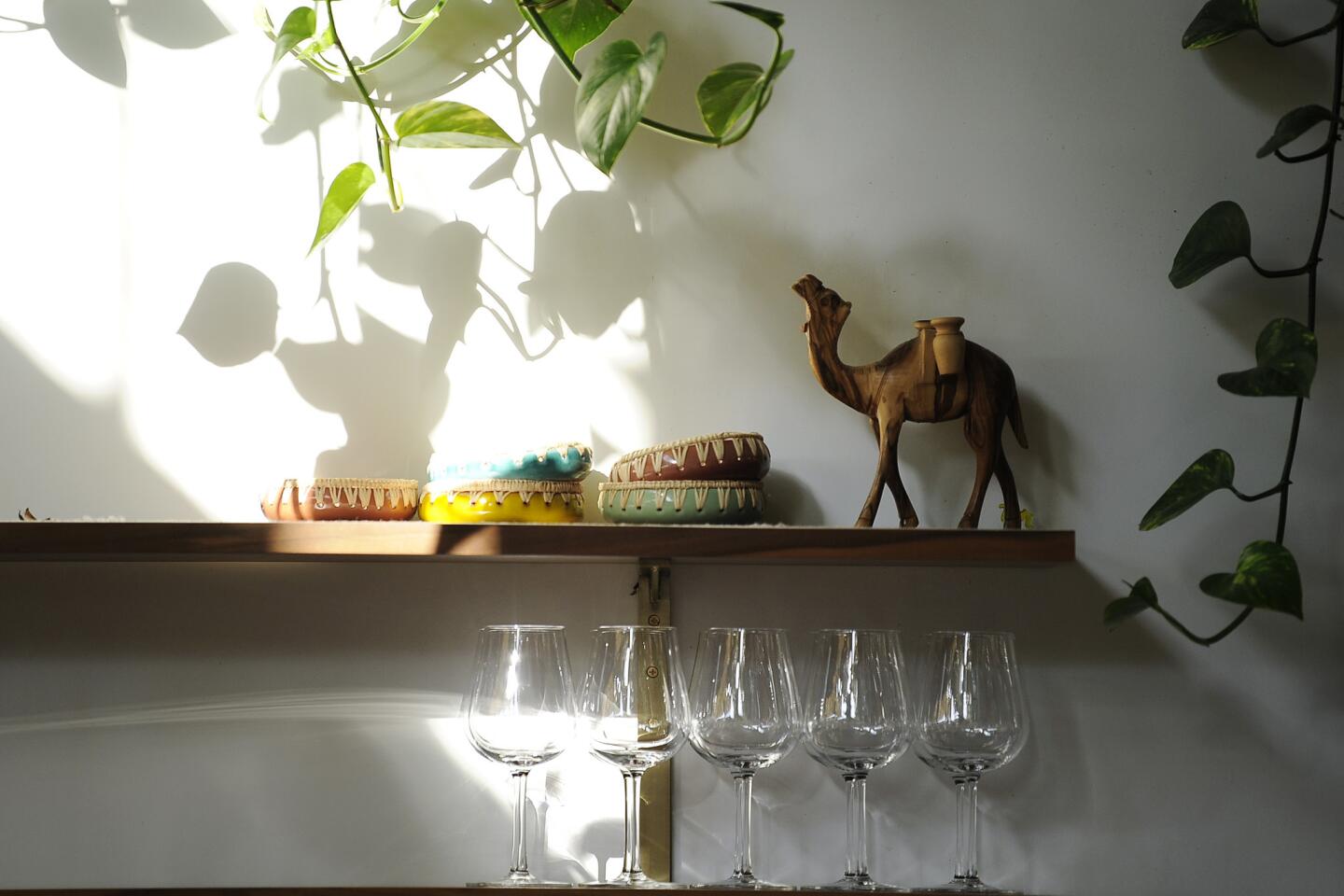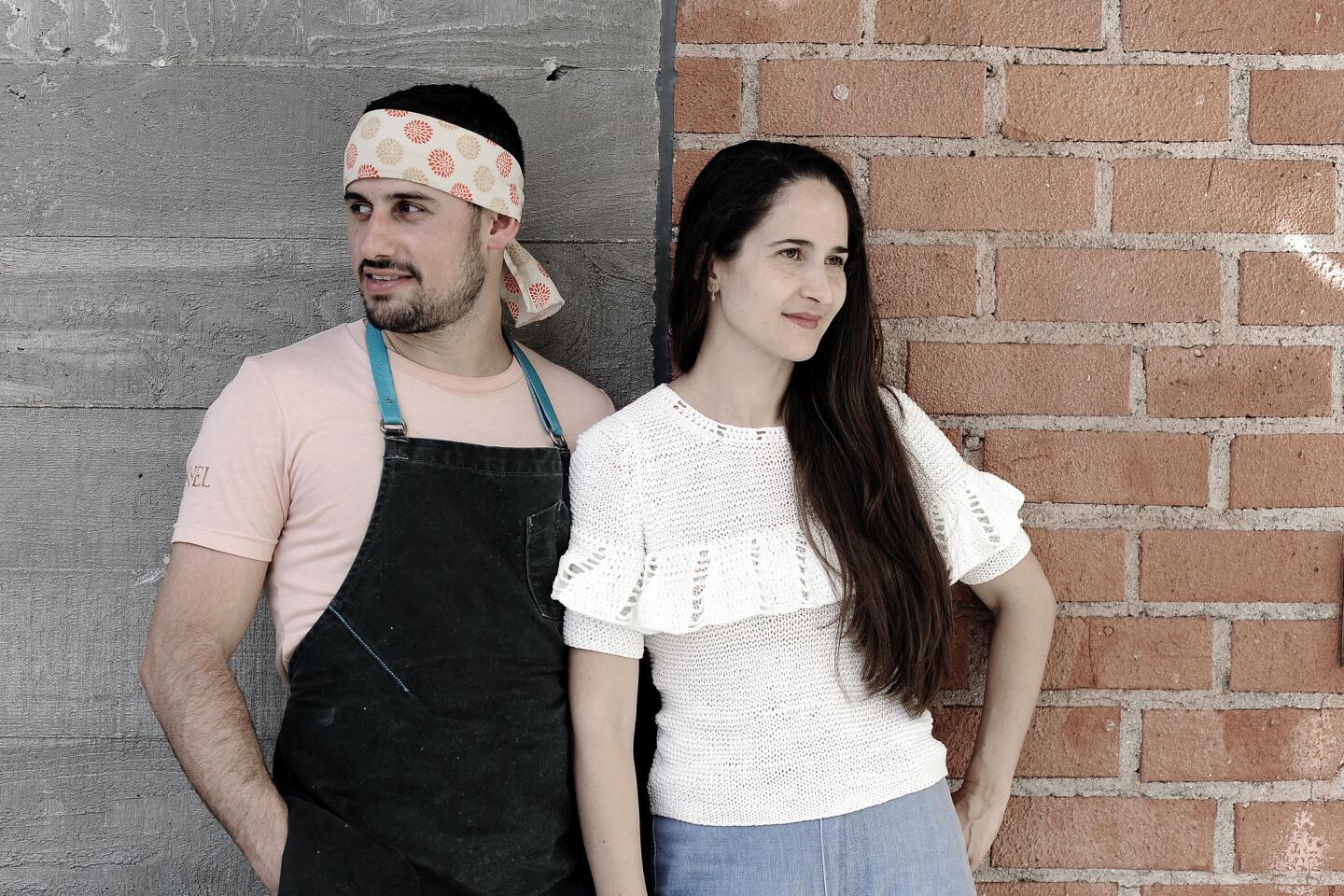Review: At Middle Eastern restaurants, it all starts with hummus. Jonathan Gold says Bavel’s is magnificent
- Share via
The seriousness of a Middle Eastern restaurant rests in its hummus. Grainy, vaguely sour hummus is OK to send off in your children’s brown-bag lunches, and the mayonnaise-y over-garlicked stuff may be exactly what you want to see alongside a takeout roast chicken. The mealy paste that comes next to the watery tabbouleh on a mezze plate serves its purpose. But the great kitchens, the ones that inspire hour-long drives and dinnertime haiku, tend to labor over their fragrant goo as assiduously as a French baker might over her baguettes. Great hummus must never be taken for granted.
So while the overwhelming popularity of Bavel may have a lot to do with the grilled octopus with yogurt or the marinated okra with whipped feta and mint, or Genevieve Gergis’ date crème brûlée, I am guessing that it is the hummus that keeps Ori Menashe up at night. The rest of the menu is pretty eclectic, and the chef-owner can creditably claim that most of the dishes are less Yemenite or Moroccan or Israeli than they are in some way his own, but you can’t fake hummus. It is either on point, or your grandmother goes home.
Menashe’s hummus is magnificent, a ring of silky, airy purée surrounding a big spoonful of chunkier, denser stuff; a green rivulet of olive oil; smears of spicy, smoky harissa and green puréed herbs. The pita has inflated into a sphere on the hot fire, but its interior has the lovely, evolved gluten network of a slow-risen country loaf. And as you scrape the bread between one density and the other, through the oil or not, the dish becomes an essay in the nuances of texture and fragrance, a nifty, chefly trick.
Bavel is a soaring converted warehouse near downtown’s 4th Street Bridge, on a block where Sonic Youth once played a free show on the street; all brick and chunky wood, an eccentric acreage of orange tile, and what looks like a forest of air plants cascading from a huge frame that is improbably not anchored with macramé. The cooks in the open kitchen knot bandannas around their foreheads in the style made famous by Menashe at his nearby restaurant Bestia. If you have spent time at Bestia, you will not be surprised to hear that Bavel is also extremely loud, averaging 92 decibels on a recent Tuesday.
You will be drinking salty island wines from Sardinia and the Canary Islands. Your date will barely hear you above the din. You will wonder whether there is a point to an old-fashioned made with lamb-fat-washed bourbon or a pisco sour with pink peppercorns, and you will decide that there might be. You will probably be having a very good time.
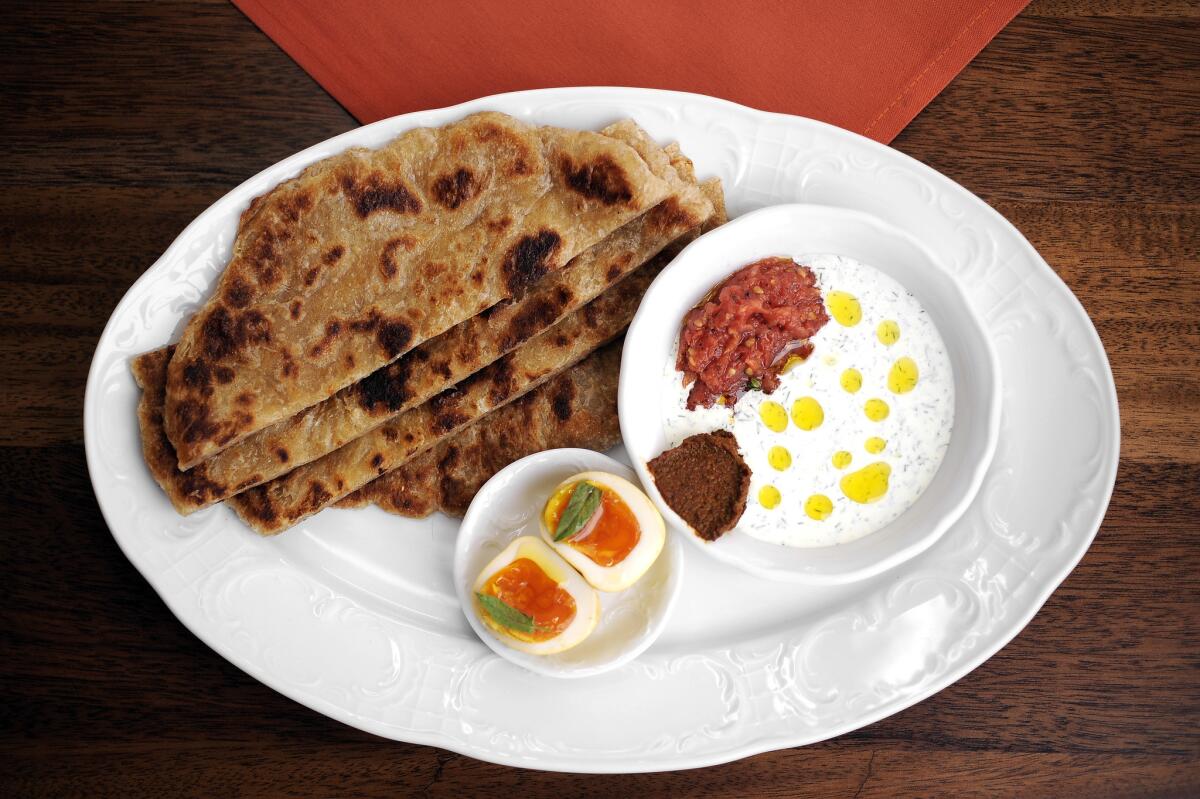
Long before last year’s wave of Israeli restaurants washed over Los Angeles, restaurant obsessives had been waiting for Bavel, a project Menashe announced not long after he opened Bestia. He had been cooking Italian food for most of his career, but he grew up in Israel, and some of Bestia’s best dishes leaned toward the Eastern Mediterranean as much as they did toward Italy.
Nobody in town was really cooking full-throttle Levantine food powered by anything like Menashe’s reliance on woodfire, house-cured meats and fermented vegetables, and at a time when everyone you knew had at least one Yotam Ottolenghi cookbook on their shelves, everybody yearned for a restaurant that would do for Middle Eastern cooking what Spago had done for Italian food a decade before.
So if you were already a fan of Menashe’s food, you almost knew what to expect: crisp lamb flatbread, like Armenian lahmajoun in a midlife crisis, zapped with chile, and mint, or a salad of cucumber and shaved artichoke hearts tossed with celery, orange blossom water and a sprinkling of crushed pistachio. The cured meat plate runs Middle Eastern instead of Italian, with spicy housemade versions of the Armenian sausage sujuk, Turkish basturma and harissa-spiked salami instead of prosciutto and speck.
The slabs of blackened, turmeric-yellow cauliflower, roasted over a hot wood fire, are scented with the cardamom-rich Yemenite spice blend hawaij and served with a bit of spicy crème fraîche as a dipping sauce. The best dish at Bavel could well be the grilled oyster mushrooms, chewy as flank steak, with a bitter wild nettle purée and an electric sprinkle of tart sumac. Almost everything seems touched with fire and cumin; coarse salt and fresh mint.
But there is also the smooth, cool fresh cheese, perfumed with toasted fig leaf and dried borage blossoms, and what Menashe calls foie gras halvah, which is to say duck liver whipped with sesame and served with slabs of grilled buckwheat toast. The crisp, flaky malawach, a Yemenite flatbread that you see in most Israeli cafes, is stupendously good here, hinting at stolidness but exploding into a hundred layers when you bite into it, rich but not oily, served with dabs of tomato pulp, herbed cream and even spicy fermented strawberry jam, a take on the herb sauce zhoug.
The emblematic dish at Bestia lately has probably been the lamb neck, a huge, soft, profoundly meaty slab that he finishes with a slash of tart salsa verde. So it makes sense that the best big meat dish at Bavel is the lamb neck “shawarma,” slow-roasted until it almost collapses in on itself, charred and smoking, laminated with a spice-shopful of herbs, with fermented cabbage, pungent tahini, and crunchy turnip pickles. (Menashe says he has a cook working full-time on just the spice blends, and I can believe it.) You carve off a bit of the dripping meat, tear off a scrap of hot laffa bread, tuck in the vegetables — you have constructed the ultimate taco al pastor of the Middle East, and the rich meat seems to transform from solid to ethereal liquid in an instant.
The spice rubbed half duck is lovely, and the beef cheek tagine with couscous tastes like the best thing you ever made out of an Ottolenghi book, but you are going to want to try the shawarma at least once.
Middle Eastern dinners don’t tend to be long on sweet endings, unless you count a cookie or two or a handful of dates to nibble with your mint tea. Gergis goes a different direction. Her baklava is an alternative Georgian version, paglava, that resembles a babka wrapped in crisp pastry, and her oozing chocolate doughnut holes are Middle Eastern only in the hint of rosewater. And her best dessert — a puck of chocolate-enrobed licorice ice cream with Maldon salt, a dead ringer for the chocolate-covered Lakrids licorice candy from Denmark — may be Middle Eastern only in that the licorice root comes from the region. I take home pounds and pounds of that salty licorice every time I go to Copenhagen. I couldn’t have been happier to taste its essence in a formal dessert.
Bavel
Ori Menashe and Genevieve Gergis translate the Middle East to downtown L.A.
Location: 500 Mateo St., Los Angeles, (213) 232-4966, baveldtla.com.
Prices: Spreads, $11-$19; flatbreads $16-$17; appetizers $7-$24; entrees $38-$42.
Details: 5-11 p.m. Sundays and Tuesdays to Thursdays; 5 p.m. to midnight Fridays and Saturdays. Credit cards accepted. Full bar. Valet parking.
Recommended dishes: Hummus; malawach; grilled oyster mushrooms; lamb-neck shawarma; licorice ice cream bonbon.
More to Read
Eat your way across L.A.
Get our weekly Tasting Notes newsletter for reviews, news and more.
You may occasionally receive promotional content from the Los Angeles Times.

